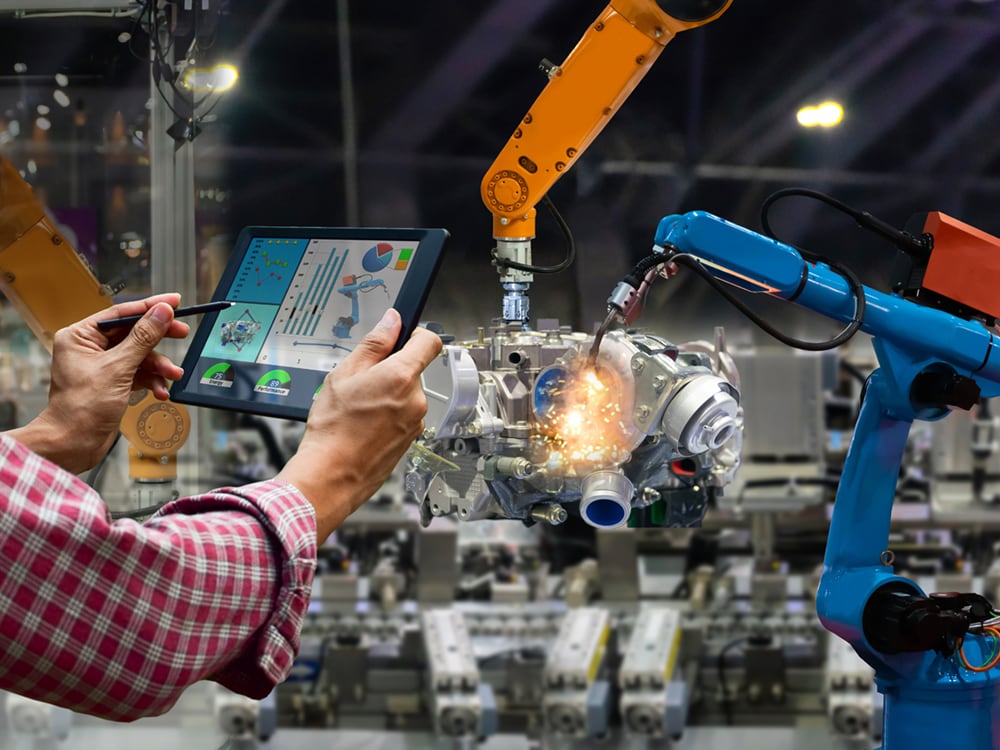 By Stephen Watts October 12, 2023
By Stephen Watts October 12, 2023
Predictive maintenance is a maintenance strategy that uses machine learning algorithms trained with Industrial Internet of Things (IIoT) data to make predictions about future outcomes, such as determining the likelihood of equipment and machinery breaking down.
Using a combination of data, statistics, machine learning and modeling, predictive maintenance is able to optimize when and how to execute maintenance on industrial machine assets. Through this predictive analysis, predictive maintenance helps avoid costly repairs, as well as maximize the utilization and availability of the equipment in service.
Predictive maintenance takes into account estimated service intervals, as well as data-driven insights based on the measurement of operating conditions to monitor and diagnose equipment issues in real time. As a result, it catches anomalies in automated operations before they become major challenges that could impact the business. In most cases today, the objectives of predictive maintenance programs can be boiled down to improved production, maintenance and operational efficiency.
Predictive maintenance is becoming increasingly important because of its efficiency in isolating and identifying system, production and other failures before they occur, thus decreasing downtime and waste. Monitoring is made easier through the use of sensors, which can keep tabs on things like machine conditions, and sensor data that pairs with traditional log data from databases and cloud storage systems for advanced insight into a combined technical infrastructure. This creates a pool of archived data, creating opportunity for the analysis of machine data for diagnostic and maintenance purposes. The ability to discover patterns and signals from sensor data enables organizations to look around corners, apply maintenance strategies at the right time and ultimately predict the next equipment failure or catastrophic event.
In this blog post, we’ll discuss maintenance in general, different types of maintenance strategies and additional resources on predictive maintenance.
The importance of a maintenance strategy
Maintenance is the process of inspecting, repairing and maintaining machinery and equipment to ensure that all equipment and machinery required for production is operating at 100% efficiency at all times. Maintenance is critical to the business, as machinery breakdown can lead to downtime and production delays, which hurt the bottom line.
In many industries, maintenance work frequently represents a high percentage of overall operating costs. Because a certain degree of unpredictability exists with equipment and machinery, companies often struggle to accurately estimate costs. A company's productivity and profitability are at least partially dependent on cost-effective maintenance strategies. Organizations need to implement thorough, optimized processes to ensure functionality and reliability throughout their plants.
Ultimately, there is no such thing as a perfect maintenance strategy. There’s no way to guarantee that a machine or piece of equipment won’t fail. Fortunately, advancements in technology have ushered in new and smarter maintenance strategies, such as predictive maintenance, which enables a proactive approach instead of a reactive one. By crafting a well thought-out maintenance management plan — combining multiple types of maintenance — organizations can better plan for the expected — and unexpected — ahead of time.

Planned vs Unplanned Maintenance
There are two types of maintenance: unplanned and planned. The former, also known as reactive maintenance, is conducted when equipment has already failed. Planned or scheduled maintenance happens before a failure occurs. There are several types of scheduled maintenance, but the two major types discussed in this article are preventative and predictive.
What are the common types of maintenance?
There are many varieties of maintenance strategies, but the most prominent ones include reactive, preventative and predictive.
- Reactive (corrective) maintenance: Reactive maintenance is a type of unplanned maintenance. Also known as corrective or breakdown maintenance, this strategy doesn’t attempt to predict issues ahead of time, but simply addresses problems as they occur. Despite low upfront costs and planning, this is a short-sighted approach that incurs high costs because of unexpected downtime, shortened life expectancy of machinery, inefficient time usage, and safety issues, among other things.
- Preventative maintenance: Preventative maintenance is a maintenance strategy that typically entails regularly scheduled service throughout the lifecycle that’s intended to keep equipment up and running. This strategy requires diligent planning and scheduling before a problem occurs, in addition to keeping accurate records of service reports and past inspections. Because of this, preventative maintenance activities can be expensive and time consuming.
- Predictive maintenance: Predictive maintenance is a type of planned maintenance, like preventative maintenance. However, unlike preventative maintenance, predictive maintenance takes into account estimated service intervals, as well as data-driven insights based on the measurement of operating conditions, to monitor and diagnose equipment issues in real time. This helps catch anomalies in automated operations before they become major challenges that could impact the business. One drawback to predictive maintenance is that it can be expensive to implement, often requiring an extensive technology investment. Despite these upfront costs, businesses can expect to see a variety of benefits, including a 10X return on investment within the first two years, as well as a reduction in maintenance costs between 25% and 30%.
- Condition-based maintenance: A subset of predictive maintenance, condition-based maintenance occurs when the need arises, using real-time data to observe the state of the machinery and equipment. Condition-based maintenance (and therefore predictive maintenance) relies on a process called condition monitoring that monitors various metrics in machinery — such as temperature and vibration, among others — to identify any changes that signal a developing issue. This allows businesses to address conditions that may potentially shorten the lifespan of a machine by appropriately scheduling maintenance as needed.

Predictive vs Preventative Maintenance
Although both preventative and predictive maintenance fall under the umbrella of planned maintenance, they have distinct differences. Essentially, preventative maintenance relies on data that indicate when failures typically occur, triggering a preemptive action.
Regularly scheduled preventative maintenance can also predict failures caused by anticipated wear and tear, triggered by time, events and meter readings. While this reduces the impact of breakdowns, it sometimes incurs early or unnecessary maintenance costs.
Predictive maintenance relies on the actual condition of mechanical equipment, in which data, statistics, machine learning and modeling are all pulled together to help determine — and preempt — problems.
Benefits of Predictive Maintenance
The business benefit of predictive maintenance is reduction in the cost of maintenance and losses associated with breakdowns. Preventing breakdowns increases productivity in manufacturing settings, and improves customer experience where breakdowns or errors would affect end users.
In the industrial world, downtime can cost organizations millions of dollars per day. Unplanned maintenance can cost 12% to 15% more than planned maintenance, and the additional urgency required to get operations back online can further add to cost and risk.
As a result, forward-leaning organizations are adopting predictive maintenance strategies. Predictive maintenance takes into account estimated service intervals while taking advantage of data-driven insights based on the measurement of operating conditions. By using statistical thresholding or modeling and forecasting to calculate when repairs are required, organizations that adopt predictive maintenance strategies are able to better manage parts and labor costs along with asset availability.
Predictive maintenance and industry 4.0
Industry 4.0 is the fourth wave of industrialization transformation, an era that builds upon and refines technological advancements made in the last industrial revolution. This prior era, known as the third industrialization wave, introduced new levels of efficiency with digital technology and automation. But it also introduced new problems (e.g., data integrity, service and maintenance complexity, increased expenses, breaches, etc.). Industry 4.0 is addressing these new issues with advances in data connectivity and technology intended to transform maintenance services and security.
Such technology trends as the Internet of Things (IoT), cloud, big data and analytics, advanced analytics, machine learning, artificial intelligence and augmented reality are converging to enable new maintenance strategies that improve availability, reduce costs, increase safety and ultimately eliminate unplanned downtime.
The Bottom Line: Predictive maintenance is transformative
No matter the industry, predictive maintenance tools have a substantial impact on efficiency, productivity and profitability. Organizations in industries such as manufacturing, energy and utilities, transportation and healthcare are already transforming their maintenance operations. Companies that do not adopt predictive maintenance strategies are likely to fall behind, or lose out on a significant competitive advantage.
What is Splunk?
This posting does not necessarily represent Splunk's position, strategies or opinion.
